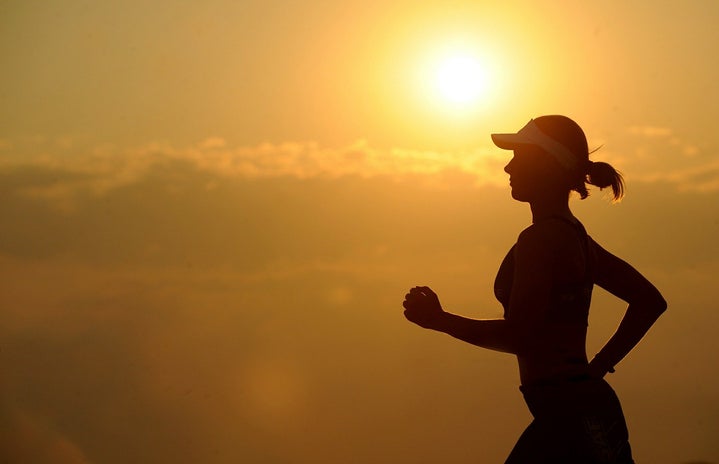This week marked ‘Scottish Women and Girls in Sport Week’, a celebration of female athletes to encourage women and girls to get active and get involved. The campaign promotes the physical, mental and social benefits of physical activity for women’s general well-being, with this year’s launched by a short film staring Leanne Crichton, a Scottish footballer who boasts an impressive 72 caps for her country. The campaign reminds me of my old games mistress’s “gung-ho” attitude, although, admittedly a flashier version offering more fundamental improvement in my well-being than a game of rounders, glass of squash and a digestive biscuit.
I love sport and couldn’t recommend anything better than raising your heart rate with a bit of exercise to combat stress, anxiety, tiredness, and nerves. Time spent exercising, no matter how brief or low intensity, is never time wasted. Every step, jump and lift contributes to a better functioning body, and every second is time and energy dedicated to yourself, regardless of whether you are with other people.
Scrolling through Instagram and TikTok, it’s hard not to come across photos of girls playing tennis in matching white dresses and immaculate trainers, fitness instructors explaining their perfect split or women sporting the perfect slicked-back ponytail posting a ‘come with me for a 10km run’ reel. Unsurprisingly, #runtok has grown exponentially, with brands like ASICS now using the trend as a monitoring tool for their global markets. This really is the age of the active girl who takes the stairs, never the lift, wakes up at 5am for her Pilates class and always hits her step count. Not only is unattainable for the majority of women, the depiction of female exercise in social media promotes it with an “all or nothing” mentality which feeds into the long held motion that if a woman does something, she must do it perfectly or not at all.
My experience with sport has been built upon a “go for it” mentality. I have never not come off the hockey pitch, tennis court or running track sweaty, panting and a slightly alarming shade of red. I’m not unfit but I leave nothing to spare when it comes to sport. As much as I love seeing other women being active and do find myself turning to Instagram as motivation, I can’t help but wonder why everyone else’s workouts seem almost enchanting in their minimalist settings, pre-workout rituals and colourful aesthetics, yet min are often filled with struggle. I don’t necessarily mean the exercise itself; like I said, I adore sport, but sometimes I find being a woman so damn frustrating when it comes to fitness. Being a woman in sport isn’t always pretty; it can sometimes be pretty ugly.
I’ll start with the obvious: the menstrual cycle. Cycle syncing is. A wonderful thing and something more women should be encouraged to try to maximise fitness results and better grasp how their body fluctuates monthly. During the luteal phase, the week before menstruation, female bodies undergo various changes. Many women will experience bloating, trouble sleeping, headaches, breast swelling or tenderness and find physical performance drops While menstruating, women many feel weak and struggle to lift their usual warm-up weights or can’t entirely concentrate during a match, thus might be better off turning to lighter exercise forms instead. The effects of the luteal and menstrual phases are temporary and are balanced out by ovulation, when women are most likely to have more energy, feel physically better and potentially hit a few personal bests. This variation in performance can be highly frustrating for women who might constantly feel like they take a step back once a month, especially compared to their male counterparts whose daily rather than monthly hormonal cycle has minimal impact on performance. The mental stress of monthly variation can be hard-hitting for those in team sports, who may feel they’re letting other players down or whose coaches might not understand why they aren’t up to standard. It is equally challenging for those in individual sports who often rely on seeing improvement as motivation.
On top of the physical changes that come with the menstrual cycle, there are also the practicalities of being a menstruating person and the need for specific facilities to accommodate our needs. Stretching, bending, squatting and running can shift the position of pads or tampons and make one susceptible to leaks when exercising. My experience playing hockey has been far from glamorous, as matches can overrun and accidents happen, sometimes resulting in a big clean-up job once the whistle has blown. Fortunately, our home ground at St Andrew’s has toilets and sanitary products directly on hand. Still, countless times I have been left to walk across fields or wait until I find a service station (all in a highly unforgiving short skort) to find a toilet. These toilet trepidation have haunted my in my running too, where lack of facilities on long runs has left me finishing the run bloated, uncomfortable and lugging what feels like a water ballon inside me along the final stretch. Whilst official races offer athlete porta-loos, rarely are they stocked with toilet paper, let alone emergency sanitary products, and sacrifice far more time for female athletes than their male equivalents.
One of my biggest frustrations, and the once I have struggled with the most growing up, has been body shape and the physical and mental implications it has for me in sport. I am by no means a naturally athletic build, certainly not the stereotypical body of a runner. Growing up as a naturally large-chested girl, I rarely saw female athletes or even teammates who looked like me. The women I watch on Runtok are tall and leggy and can enjoy wearing cute (and tiny!) sports sets for their workouts. If I attempted a run in such an outfit, I can guarantee I would experience immense chaffing 3km in and my boobs would be jumping around so much I would be terrified they might pop out! Sports bras, for those of us above a DD, act more like scaffolding than a fashion statement, securing everything in place to prevent back pain and discomfort. The struggle of getting such a contraption on is a workout in itself and sometimes feels more like a Victorian corset than something to enhance my athletic performance.
The truth is that sometimes it feels like my female body is working against me when I exercise. Even if my period is not due, it can feel like nothing, be it boobs or thighs, is built for movement beyond a walk. So, even though my coaches and old games mistress will hate me for it, I fully advocate for women who complain about exercising. As much as I love it, being an active woman can be painful, uncomfortable, impractical and embarrassing, but this is why we deserve so much more credit than we are given. It is not necessarily easy to “get on with it”, yet so many women do so with grace, decorum and a great deal of style. I will continue to be inspired by the fitness influencer industry and campaigns like ‘Women and Girls in Sport’…but I greatly anticipate finding a ‘run with me’ video that includes a p*ss-break or hearing a fitness influencer recommend an E-cup sports bra simply because the zip didn’t come undone mid-workout.


